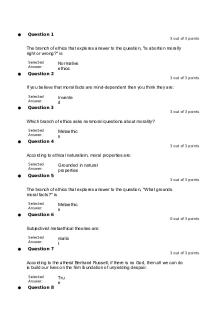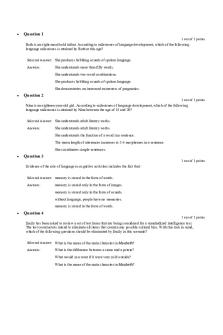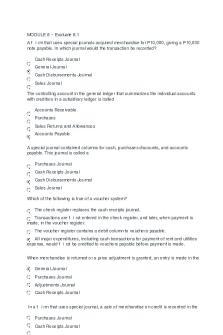Quiz 8 Notes - Damien Brooks PDF

| Title | Quiz 8 Notes - Damien Brooks |
|---|---|
| Author | Kiet Le |
| Course | Survey Of Investments |
| Institution | University of Georgia |
| Pages | 3 |
| File Size | 76.3 KB |
| File Type | |
| Total Downloads | 94 |
| Total Views | 140 |
Summary
Damien Brooks...
Description
FINA 4310: Quiz 8 Study Guide -“Derivative”: financial contract whose value “derives” from a security/asset/market index (doesn’t have a cash flow) -Financial option: contract that gives its owner the right, not obligation to purchase/sell an asset at a fixed price at some future date -Call option: right to buy | Put option: right to sell -“strike price” aka exercise price: price at which they buy/sell -2 types of options: American vs European (typically options on indices) | not necessarily “geography” -Buyer “long” seller “short” -Open interest: “volume” – number of contracts of a particular option that have been written Trading option: -Individual stock options: physically settled/ use the right to sell/buy the underlying security need to make “second trade” -Index options: typically cash settled Option quote includes: ticker symbol, the year, month (in alphabet which indicates call/put) , day, strike price we don’t know current stock price Calls: A-L and Puts: M-X “Moneyness” -Near the money: an option exercise price is close to strike price -At the money: exercise price equals the current stock price (S=X) -In the money: S>X for call, X>S for put -Out of the money: X>S for call, S>X for put Why Options? -Hedging: reduce risk by holding options whose payoffs are negatively correlated with some risk exposure -Speculate: Using options to place a bet on the direction the market is likely to move Option Payoffs -Never have negative payoff when we are long an option -“Zero sum game”: if long position has a gain, the short position must have a loss -Option writer will never have a positive payoff =$0 is best case for short position Option strategies: -Straddle: a portfolio that is long a call and a put on the same stock with the same expiration date and strike price payoff any time the price does not remain constant at the strike price
1
-Strangle: a portfolio that is long a call and a put on the same stock with the same exercise date, but the strike price on the call exceeds the strike price on the put; lower payoffs than straddle, but cheaper -Butterfly Spread: a portfolio that is 1 long call option at X1, 1 long call option at X3, short 2 call at X2 = ½ (X1+X3) profit when price stays near X2 -Protective Put: a long position in a put held on a stock you already own; guarantees minimum proceeds equal to the put’s exercise price effective in guaranteeing sale price but more expensive; -Portfolio Insurance: a protective put written on a portfolio rather than a single stock; portfolio insurance achieved by purchasing a bond and a call option. Put-Call Parity: S + P = PV(X) + C -2 assumptions: options are European and stocks don’t pay dividend -3 other things: -The put and call to be on the same underlying security -The put and call to have the same expiration date -The put and call need to have same exercise price Option value includes intrinsic value and time value Arbitrage bounds: (1) a call option cannot payoff more than the stock itself (2) a put option cannot be worth more than its strike price (3) An American option cannot be worth less than its European counterpart (should be generally more valuable prior to expiration and equal at expiration) Factors affection option prices (6 of them) -Affecting intrinsic value: -Stock price: As the underlying stock price increases, the value of a call option increases; As the underlying stock price increases the value of a put option decreases -Strike price: As the exercise price increases, the value of a call option decreases; As the exercise price increases, the value of a put option increases -Affecting time value: -Interest rate: as market interest rate increase, the value of a call option increases; as market interest rate increase, the value of a put option decreases -Dividend payout: as firm dividend payout increases, the value of a call option decreases; as the firm’s dividend payout increases, the value of a put option increases -Volatility: higher volatility increases the value of all put and call options -Time to expiration: almost always increases a option’s value (can decrease the value of a (1) heavily in-the-money (2) European (3) put)
2
Delta Hedging: important in risk management -Delta changes as underling stock price changes -Delta 0.5 when an option is near-the-money (most volatile) -Delta 1 for heavily in the money option -Delta 0 for heavily out of the money option Binomial Model: replicate the option using the stock a risk free bond Two-state model: use option and the stock to replicate the risk-free bond and form a risk-free portfolio and the use that to price an option. yield same answer with binomial Multiperiod: (1) calculate prices for all nodes (2) calculate option payoffs at expiration (3) calculate a binomial for each mode Black-Scholes Formula: -Assumes that the firm pays continuous dividends at a rate -6 inputs needed: stock price, strike price, expiration date, dividend yield, risk-free rate, volatility of the stock (might be problematic to find) -Practitioner uses 2 strategies to find volatility -Historical data -“Back out” the implied volatility: take price observed in the market and back out the market estimate of the risk
3...
Similar Free PDFs

Quiz 8 Notes - Damien Brooks
- 3 Pages

Quiz 6 Notes - Damien Brooks
- 4 Pages

Quiz 8 - class notes
- 1 Pages

Quiz 8 - Quiz 8
- 4 Pages

Brooks worksheet
- 3 Pages

Quiz 8 - Weekly Quiz
- 6 Pages

Quiz Chapter 8 - Quiz
- 6 Pages

Quiz-8 - QUIZ
- 22 Pages

Buslaw QUIZ 8 - Quiz
- 6 Pages

Chapter 8 quiz #8
- 3 Pages

Quiz 8 - Chapter 8 Quiz Solved.
- 2 Pages

Chapter 8 Quiz - Weekly Quiz
- 3 Pages

Acctg quiz 8 - Accounting quiz
- 2 Pages
Popular Institutions
- Tinajero National High School - Annex
- Politeknik Caltex Riau
- Yokohama City University
- SGT University
- University of Al-Qadisiyah
- Divine Word College of Vigan
- Techniek College Rotterdam
- Universidade de Santiago
- Universiti Teknologi MARA Cawangan Johor Kampus Pasir Gudang
- Poltekkes Kemenkes Yogyakarta
- Baguio City National High School
- Colegio san marcos
- preparatoria uno
- Centro de Bachillerato Tecnológico Industrial y de Servicios No. 107
- Dalian Maritime University
- Quang Trung Secondary School
- Colegio Tecnológico en Informática
- Corporación Regional de Educación Superior
- Grupo CEDVA
- Dar Al Uloom University
- Centro de Estudios Preuniversitarios de la Universidad Nacional de Ingeniería
- 上智大学
- Aakash International School, Nuna Majara
- San Felipe Neri Catholic School
- Kang Chiao International School - New Taipei City
- Misamis Occidental National High School
- Institución Educativa Escuela Normal Juan Ladrilleros
- Kolehiyo ng Pantukan
- Batanes State College
- Instituto Continental
- Sekolah Menengah Kejuruan Kesehatan Kaltara (Tarakan)
- Colegio de La Inmaculada Concepcion - Cebu


